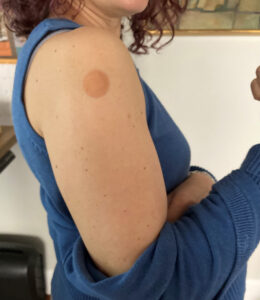CDC’s Cory ’91 Speaks on COVID-19 and Public Health

(By Bill Holder ’75)
In this Q&A we speak with Janine Cory ’91, MPH, about COVID-19 myths, vaccinations and vaccine hesitancy, pediatric transmission, health literacy, and more. Cory is the Associate Director of Communications for the CDC COVID-19 Response, Vaccine Task Force.
For more information on Wesleyan’s efforts dealing with COVID-19, visit the Keep Wes Safe website.
Q: How did you first become interested in public health? Was there a particular experience, issue, or Wesleyan course that influenced you? What led you to focus on risk communication?
A: I was actually lucky enough to be accepted into a pilot program at Mt. Sinai Medical School in 1989 that accepted a few students from Wesleyan and a couple of other schools. The idea was to take non-traditional pre-med students (I was an anthropology-sociology major) and do clinical rotations and a laboratory rotation.
I was expecting to cut up worms or something in my lab rotation, but it was what I would now label as public health and epidemiology. I discovered I had a knack for survey design and analysis during that summer and realized that public health was the intersection of medicine and sociology that I had been looking for. Even at that point, the idea of risk communication and plain language really made sense. Some of the survey questions asked consumers “is the angle of your desk and chair between 18-24 degrees?” I re-wrote it based on what probably seems obvious to everyone reading this now—don’t assume that most people would know the exact angle of their chair. When you’re collecting data, you have to make sure it’s useable in a way that helps you move forward to answer real questions.
Q: Has the COVID-19 pandemic presented any unique challenges in risk communication? If so, how have you and your colleagues addressed those challenges?
A: One thing during this pandemic that is both a good and bad element is the prevalence of social media. There’s such an influx of information—and anyone can be an influencer in any direction. It can be hard to sort out what are genuine, science-based data, and what seemingly legitimate ‘facts’ are actually based on opinion or myth. The premise behind good risk communication is understanding that you have to acknowledge where people are at and really get the context of their concerns. If you don’t recognize where their sources of data are, or where their belief system lies, throwing data or ‘facts’ at someone doesn’t help you give them useful information to change their health behavior.
This is the space where, honestly, most scientists could do a lot better; there are people who are brilliant researchers or clinicians, but we all get ‘tunnel vision’ in our jobs. For a scientist, it’s patently obvious that ‘more data are needed to draw a conclusion about safety from this study, although results are somewhat favorable’ clearly means one thing. For the general public, it’s easy to interpret that “more data are needed about safety” means something is not safe, when the opposite message was intended. It’s part of health communication science to bridge that gap between data and actionable health decisions. Cutting down on jargon and using trusted messengers goes a long way.
Q: If you could dispel one myth or misunderstanding about COVID-19, what would that be?
A: There’s a lot of concern that the vaccines are too new or were developed ‘too quickly’ to be safe and effective. This technology has actually been around for a while – both the mRNA platform that the Pfizer and Moderna vaccine use and the viral vector platform that Johnson & Johnson used, plus a coordinated, concentrated effort really pushed the research forward. Really, a few stages moved faster than usual just because of a huge amount of effort and devoted time, but these vaccines didn’t jump any regular safety testing protocols.

Q: Vaccine hesitancy has a long history. What do you think are the root causes, and what are the best ways to address it?
A: Vaccine hesitancy can have different root sources, depending on the community. People who hesitate to get a vaccine may have different reasons and not consider themselves “anti-vaxxers.” It makes sense that someone could have questions about the vaccine development and process, even if you trust science. Sometimes myths can persist from seemingly legitimate sources (like doctors whose facts have been ‘debunked’ by respected peer review), and even once discredited, that misinformation can still circulate.
A lot of us won’t admit it, but we all can be driven by emotion; anecdotal, personal stories can resonate with us, even if we ‘know’ facts. What’s important is finding sources of information that stand up to scrutiny from multiple angles, even if you disagree with them.
The bigger issue of mistrusting the government can stem from terrible harms that were done to some communities, like the African American community, decades ago. But the reality is that disparity issues and racism still exist and persist now in too many communities of color, which deeply weakens trust. Using trusted messengers—especially community-based healthcare providers like doctors, nurses, and pharmacists can be a good way to disseminate reliable information. Even if people don’t trust ‘the system,’ they usually trust their own doctor. The key is getting those trusted messengers armed with enough useful information to speak confidently about vaccination.
Q: What do you say to people about the COVID-19 risk to and from children? Are children understudied in this pandemic?
A: Normally kids are source No. 1 for germs—they’re not great hand washers, they tend to not understand even normal ‘close contact’ restrictions (anyone who has had a toddler poke them in the eye knows this), and of course they are…generally moist.
While fewer children have been sick with COVID-19 compared to adults, children can be infected with COVID-19, get sick, and even spread it. Children, like adults, can be asymptomatic and spread the virus to others, so it’s problematic when they sneeze on people at high risk. Pediatric transmission is one of the things CDC is studying.
While children may not be at as high risk of serious disease as adults, we know that there are a lot of mental health issues even healthy children are coping with at all ages and stages. There are several studies looking at this, and honestly, there may be long-term effects from these changes that ‘trickle down’ in a variety of ways, including a reflection of their parents’ anxiety (totally understandable under the circumstances with job loss and fear). CDC has some good pages to refer to for parents.
Q: How do you talk about uncertainty, about the limits of data and scientific understanding, without causing undue alarm?
A: This goes back to transparency—sometimes it does seem scary to say “we don’t know” as the answer for something. I think framing what we DO know is important, why there might be limitations on data, and what we are doing to get more information.
Q: When releasing information for the general public, how do you determine the appropriate grade level for communicating—the kind of language you can use, the assumptions you can and cannot make.
A: Over the past decade, there has been a lot more focus on health literacy. This is different from low literacy, but it’s still a stumbling block for many people, often regardless of education level. For example, you could have a PhD in history, but doctors and scientists tend to assume that we all know the ‘code’ on specific terms—like saying acetaminophen (instead of Tylenol) because we want to be specific and accurate; instead we can confuse or lose our audience. For most of us, when we are dealing with medical issues or a public health crisis, we are under acute stress. That’s not the best position to absorb new information or ask questions.
I think one of the good things about the internet is the ability to get information on your own terms and cross-check it with sources you trust. My goal at the CDC is to ensure that we use plain language, free of jargon, with straightforward explanations tailored to each target audience—whether you are a physician trying to review clinical guidelines or a parent trying to figure out if your child’s mask is on correctly (probably not, but keep trying).
Q: COVID-19 has affected all of us in one way or another. Has your personal experience had any impact on the way(s) you view risk communication?
A: During the pandemic, I saw more than ever how hungry people were for clear information, and how confusing getting multiple messages could be. My friends and family were all asking me for information when we really didn’t know a lot, and it definitely frustrated them when I didn’t have clear answers (Mom: you can stop spraying everything with disinfectant). Being deployed during the pandemic really showcased how important digestible, actionable information was when every single day seemed to be overwhelming with horrific stories of death and disease. Being able to contribute to communicating to people how to protect themselves and their family was a concrete way for me to feel like I was actually doing something.

